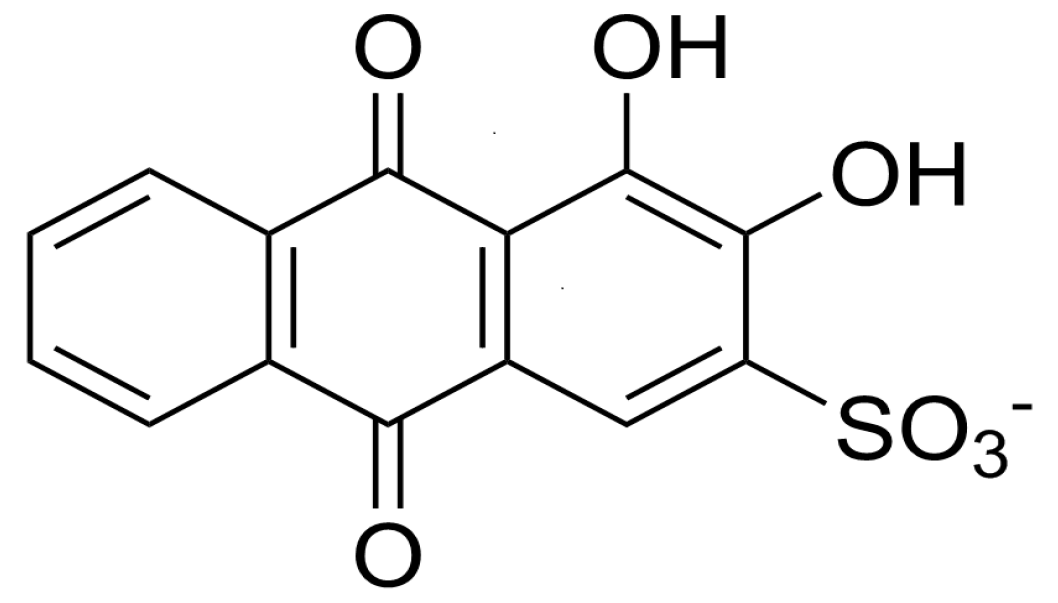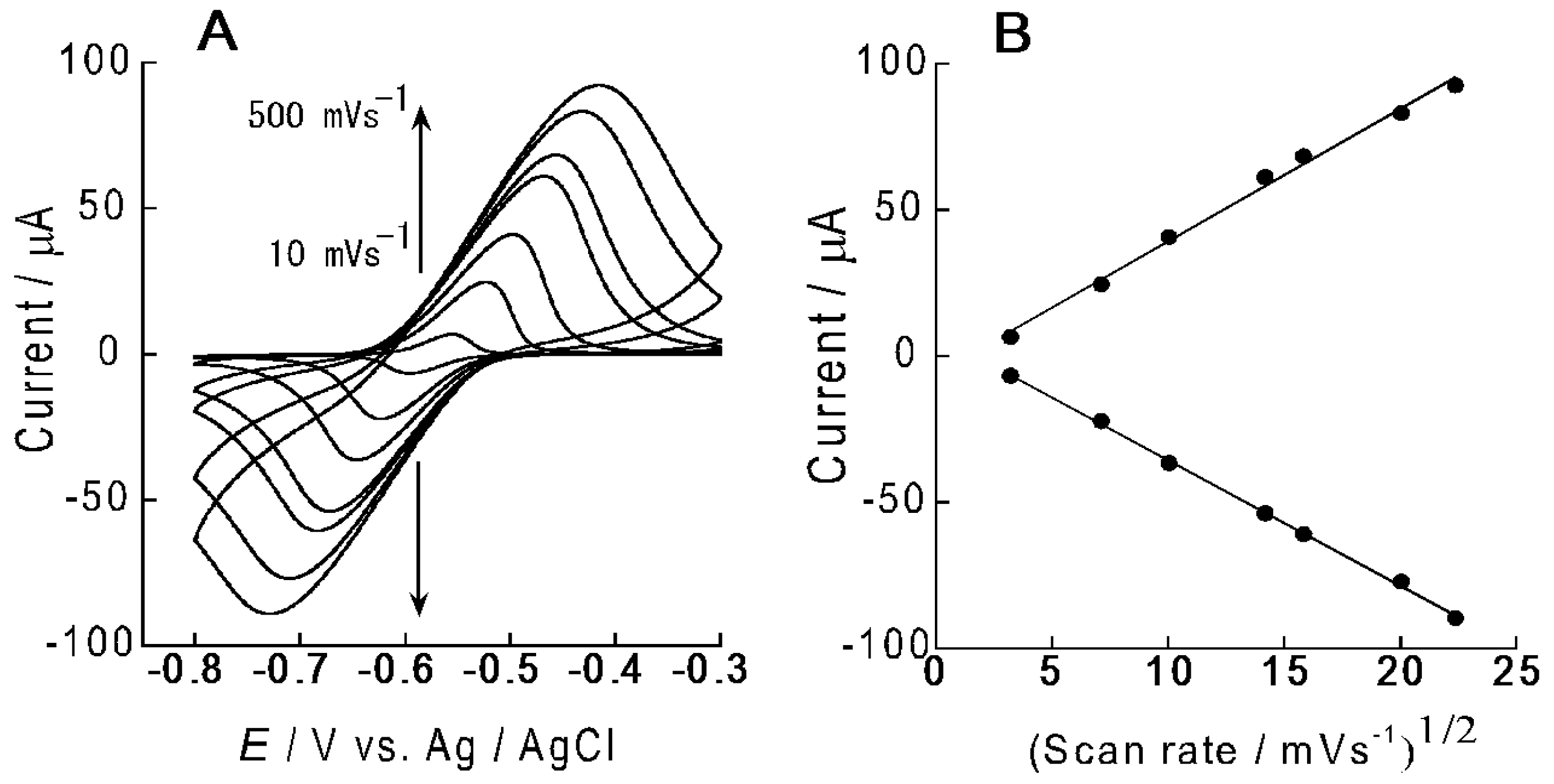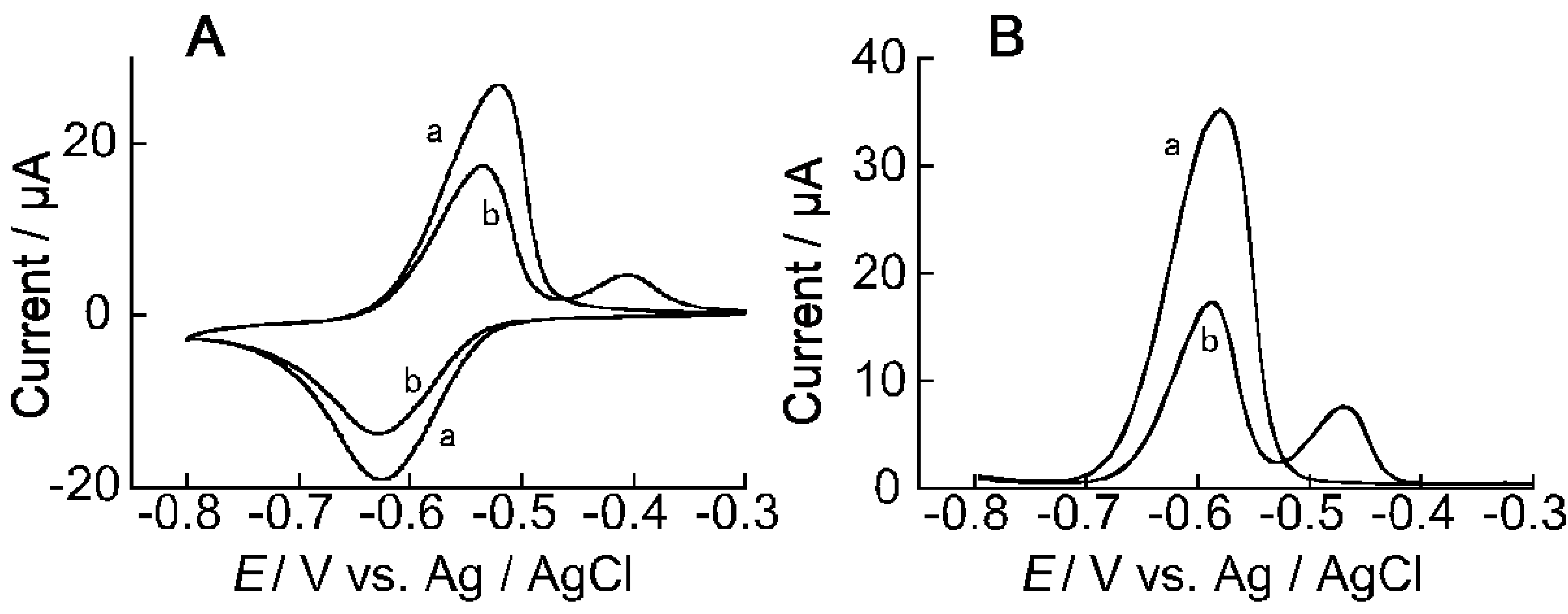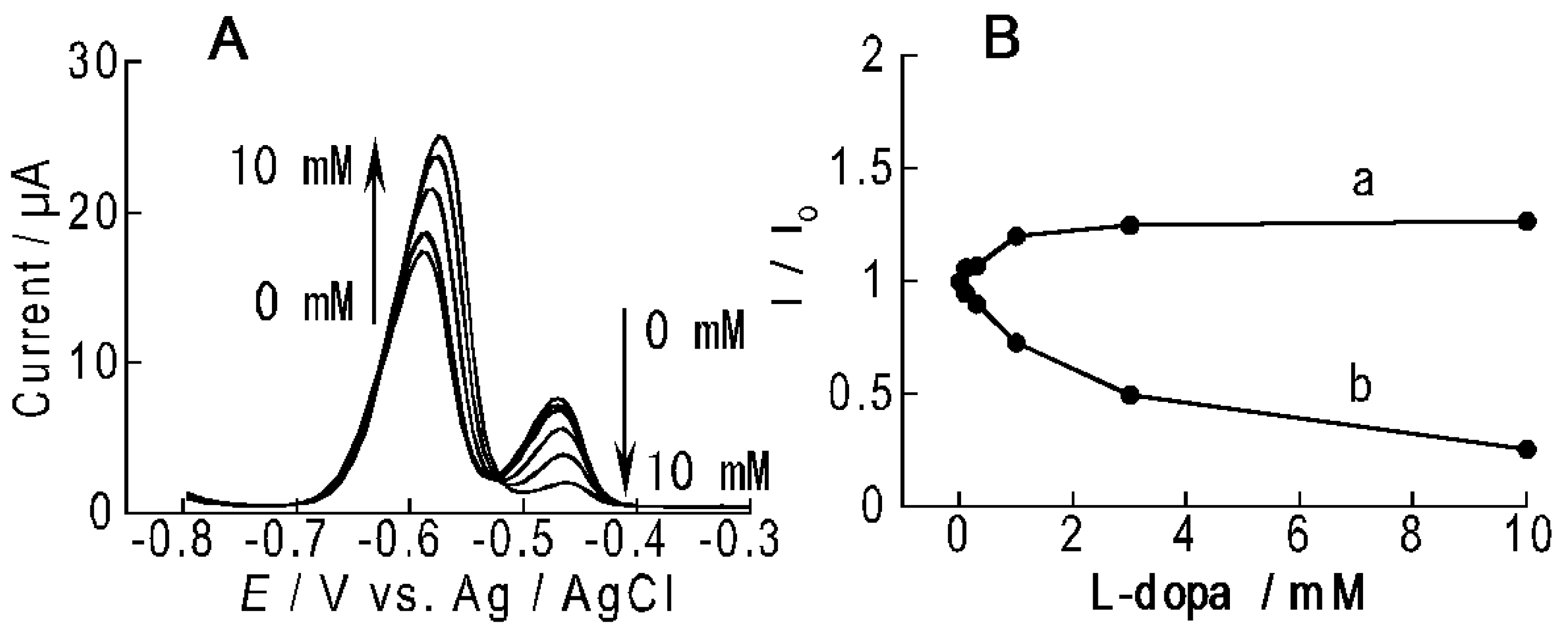Alizarin Red S-Confined Layer-By-Layer Films as Redox-Active Coatings on Electrodes for the Voltammetric Determination of L-Dopa
Abstract
:1. Introduction
2. Materials and Methods
2.1. Reagents
2.2. Preparation of ARS-Confined LbL Films
2.3. Atomic Force Microscopy (AFM)
2.4. Electrochemical Measurements
3. Results and Discussion
3.1. Immobilization of ARS in PEI/CMC LbL Films
3.2. Redox Properties of ARS in PEI/CMC LbL Films
3.3. Redox Properties of ARS-Immobilized PEI/CMC LbL Film in the Presence of PBA
4. Conclusions
Acknowledgments
Author Contributions
Conflicts of Interest
References
- Iost, R.M.; Crespilho, F.N. Layer-by-layer self-assembly and electrochemistry: Applications in biosensing and bioelectronics. Biosens. Bioelectron. 2012, 31, 1–10. [Google Scholar] [CrossRef] [PubMed]
- Sato, K.; Takahashi, S.; Anzai, J. Layer-by-layer thin films and microcapsules for biosensors and controlled release. Anal. Sci. 2012, 28, 929–938. [Google Scholar] [CrossRef] [PubMed]
- Bastarrachea, L.J.; Wong, D.E.; Roman, M.J.; Lin, Z.; Goddard, J.M. Active packaging coatings. Coatings 2015, 5, 771–791. [Google Scholar] [CrossRef]
- Tomita, S.; Sato, K.; Anzai, J. Layer-by-layer assembled thin films composed of carboxyl-terminated poly(amidoamine) dendrimer as a pH-sensitive nano-device. J. Colloid Interface Sci. 2008, 326, 35–40. [Google Scholar] [CrossRef] [PubMed]
- Malucelli, G. Surface-engineered fire protective coatings for fabrics through sol-gel and layer-by-layer methods: An overview. Coatings 2016, 6, 33. [Google Scholar] [CrossRef]
- Yoshida, K.; Sato, K.; Anzai, J. Layer-by-layer polyelectrolyte films containing insulin for pH-triggered release. J. Mater. Chem. 2010, 20, 1546–1552. [Google Scholar] [CrossRef]
- Paul, M.; Jons, S.D. Chemistry and fabrication of polymeric nanofiltration membranes: A review. Polymer 2016, 103, 417–456. [Google Scholar] [CrossRef]
- Anzai, J.; Kobayashi, Y.; Suzuki, Y.; Takeshita, H.; Chen, Q.; Osa, T.; Hoshi, T.; Du, X. Enzyme sensors prepared by layer-by-layer deposition of enzymes on a platinum electrode through avidin-biotin interaction. Sens. Actuators B 1998, 52, 3–9. [Google Scholar] [CrossRef]
- Huang, J.; Yang, Y.; Shi, H.; Sing, Z.; Zhao, Z.; Anzai, J.; Osa, T.; Chen, Q. Multi-walled carbon nanotubes-based glucose biosensor prepared by layer-by-layer technique. Mater. Sci. Eng. C 2006, 26, 113–117. [Google Scholar] [CrossRef]
- Azadmanjiri, J.; Berndt, C.C.; Wang, J.; Kapoor, A.; Srivastava, V.K.; Wen, C. A review on hybrid nanolaminate materials synthesized by deposition techniques for energy storage applications. J. Mater. Chem. A 2014, 2, 3695–3708. [Google Scholar] [CrossRef]
- Sato, K.; Kodama, D.; Naka, Y.; Anzai, J. Electrochemically induced disintegration of layer-by-layer-assembled thin films composed of 2-iminobiotin-labeled poly(ethyleneimine) and avidin. Biomacromolecules 2006, 7, 3302–3305. [Google Scholar] [CrossRef] [PubMed]
- Rounaghi, G.H.; Razavipanah, I.; Vakili—Zarch, M.H.; Ghanei-Motlagh, M.; Salavati, M.R. Electrochemical synthesis of alizarin red S doped polypyrrole and its applications in designing a novel silver (I) potentiometric and voltammetric sensor. J. Mol. Liq. 2015, 211, 210–216. [Google Scholar] [CrossRef]
- Liang, X.; Bonizzoni, M. Boronic acid-modified poly(amidoamine) dendrimers as sugar-sensing materials in water. J. Mater. Chem. B 2016, 4, 3094–3103. [Google Scholar] [CrossRef]
- Wu, H.; Jin, L. Assembly of alizarin red S/boric acid ultrathin films based on layered double hydroxide for fluorescence turn on detection of tiopronin. J. Mater. Chem. C 2016, 4, 3415–3421. [Google Scholar] [CrossRef]
- Yang, J.; He, Y.; Lai, L.; Li, J.; Song, X. Electrochemical sensors using gold submicron particles modified electrodes based on calcium complexes formed with alizarin red S for determination of Ca2+ in isolated rat heart mitochondria. Biosens. Bioelectron. 2015, 66, 417–422. [Google Scholar] [CrossRef] [PubMed]
- Schumacher, S.; Nagel, T.; Scheller, F.W.; Gajovic-Eichemann, N. Alizarin red S as an electrochemical indicator for saccharide recognition. Electrochim. Acta 2011, 56, 6607–6611. [Google Scholar] [CrossRef]
- Gu, L.; Liang, Y.; Zhou, T.; Tang, X.; Shi, G. A novel electrochemical sensor based on boronic acid-functionalized multi-walled carbon nanotubes for astragaloside IV determination using ARS as the current indicator. Anal. Methods 2012, 4, 492–495. [Google Scholar] [CrossRef]
- Huang, Y.; Jiang, Y.; Fossey, J.S.; James, T.D.; Marken, F. Assembly of N-hexadecyl-pyridinium-4-boronic acid hexafluorophosphate monolayer films with catechol sensing selectivity. J. Mater. Chem. 2010, 20, 8305–8310. [Google Scholar] [CrossRef]
- Lawrence, K.; Nishimura, T.; Haffenden, P.; Mitchels, J.M.; Sakurai, K.; Fossey, J.S.; Bull, S.D.; James, T.D.; Marken, F. Pyrene-anchored boronic acid receptors on carbon nanoparticle supports: Fluxionality and pore effects. New J. Chem. 2013, 37, 1883–1888. [Google Scholar] [CrossRef]
- Wang, B.; Anzai, J. Redox reactions of ferricyanide ions in layer-by-layer deposited polysaccharide films: A significant effect of the type of polycations in the films. Langmuir 2007, 23, 7378–7384. [Google Scholar] [CrossRef] [PubMed]
- Gao, L.; Zhang, J.; Wang, H.; Lin, X.; Qi, J.; Wang, K. Effects of elemental composition variations of Keggin polyoxometalates on photocurrent generation of their layer-by-layer self-assembled films with a hemicyanine dye. Electrochim. Acta 2015, 166, 215–222. [Google Scholar] [CrossRef]
- Turcanu, A.; Bechtold, T. pH dependent redox behaviour of Alizarin red S (1,2-dihydroxy-9,10-anthraquinone-3-sulfonate)―Cyclic voltammetry in presence of dispersed vat dye. Dyes Pigment. 2011, 91, 324–331. [Google Scholar] [CrossRef]
- Nicholson, R.S.; Shain, I. Theory of stationary electrode polarography. Anal. Chem. 1964, 36, 706–723. [Google Scholar] [CrossRef]
- Ohsaka, T.; Takahira, Y.; Hatozaki, O.; Oyama, N. Charge-transfer rates in thin polyelectrolyte films incorporating a redox molecule with two separate electroactive centers having different redox potentials. An alizarin red S―Cationic perfluoropolymer film system. Bull. Chem. Soc. Jpn. 1989, 62, 1023–1031. [Google Scholar] [CrossRef]
- Batcheloer-McAuley, C.; Kozub, B.R.; Menshykau, D.; Compton, R.G. Voltammetric response of surface-bound and solution-phase anthraquinone moieties in the presence of unbuffered aqueous media. J. Phys. Chem. C 2011, 115, 714–718. [Google Scholar] [CrossRef]
- Springsteen, G.; Wang, B. A detailed examination of boronic acid―Diol complexation. Tetrahedron 2002, 58, 5291–5300. [Google Scholar] [CrossRef]
- Quintino, M.S.M.; Yamashita, M.; Angnes, L. Voltammetric studies and determination of levodopa and carbidopa in pharmaceutical products. Electroanalysis 2006, 18, 655–661. [Google Scholar] [CrossRef]
- Shahrokhian, S.; Asadian, E. Electrochemical determination of L-dopa in the presence of ascorbic acid on the surface of the glassy carbon electrode modified by a bilayer of multi-walled carbon nanotube and poly-Pyrrole doped with tiron. J. Electroanal. Chem. 2009, 636, 40–46. [Google Scholar] [CrossRef]
- Takahashi, S.; Anzai, J. Phenylboronic acid monolayer-modified electrodes sensitive to sugars. Langmuir 2005, 21, 5102–5107. [Google Scholar] [CrossRef] [PubMed]
- Jiang, G.; Jiang, T.; Wang, Y.; Du, X.; Wei, Z.; Zhou, H. Facile preparation of novel Au-polydopamine nanoparticles modified by 4-mercaptophenylboronic acid for use in a glucose sensor. RSC Adv. 2014, 4, 33658–33661. [Google Scholar] [CrossRef]







© 2017 by the authors. Licensee MDPI, Basel, Switzerland. This article is an open access article distributed under the terms and conditions of the Creative Commons Attribution (CC BY) license (http://creativecommons.org/licenses/by/4.0/).
Share and Cite
Takahashi, S.; Suzuki, I.; Sugawara, T.; Seno, M.; Minaki, D.; Anzai, J.-I. Alizarin Red S-Confined Layer-By-Layer Films as Redox-Active Coatings on Electrodes for the Voltammetric Determination of L-Dopa. Materials 2017, 10, 581. https://doi.org/10.3390/ma10060581
Takahashi S, Suzuki I, Sugawara T, Seno M, Minaki D, Anzai J-I. Alizarin Red S-Confined Layer-By-Layer Films as Redox-Active Coatings on Electrodes for the Voltammetric Determination of L-Dopa. Materials. 2017; 10(6):581. https://doi.org/10.3390/ma10060581
Chicago/Turabian StyleTakahashi, Shigehiro, Iwao Suzuki, Tatsuro Sugawara, Masaru Seno, Daichi Minaki, and Jun-Ichi Anzai. 2017. "Alizarin Red S-Confined Layer-By-Layer Films as Redox-Active Coatings on Electrodes for the Voltammetric Determination of L-Dopa" Materials 10, no. 6: 581. https://doi.org/10.3390/ma10060581




